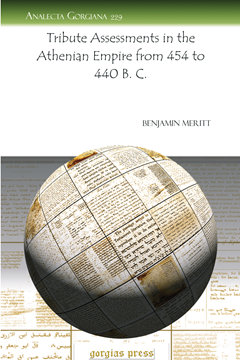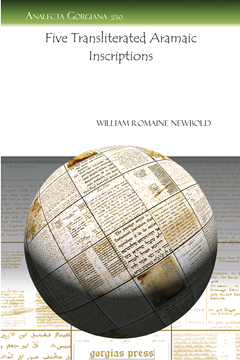Tribute Assessments in the Athenian Empire from 454 to 440 B. C.
Series: Analecta Gorgiana 229
ISBN: 978-1-60724-458-5
Benjamin Meritt, renowned scholar of Greek epigraphy, provides transcription, text, and commentary on the surviving lists of tribute paid to Athens under the Delian league.
$38.00 (USD) $22.80 (USD)
Five Transliterated Aramaic Inscriptions
Series: Analecta Gorgiana 230
ISBN: 978-1-60724-459-2
William Newbold deciphers inscriptions found under the soot and lava of Vesuvius in which Aramaic speakers used Greek and Latin letters to render their native tongue, occasionally in a mixture of Aramaic and Latin.
$39.00 (USD) $23.40 (USD)
Mycenaean Plumes
Series: Analecta Gorgiana 231
ISBN: 978-1-60724-460-8
Holland uses sculpture to suggest that these ornaments were meant to be worn in womens' headdresses as a development from feathered crowns worn in earlier times and possibly connected to the iconography of the sphinx.
$37.00 (USD) $22.20 (USD)
Excavations in the Theatre District and Tombs of Corinth in 1929
Series: Analecta Gorgiana 232
ISBN: 978-1-60724-461-5
This is the site report from the first excavation of two key areas in Corinth, the theater district and the tombs.
$37.00 (USD) $22.20 (USD)
Jointed Dolls in Antiquity
Series: Analecta Gorgiana 233
ISBN: 978-1-60724-462-2
Kate Elderkin presents an enjoyable overview not only of the nature of children's dolls in Antiquity, but the customs surrounding their use and subsequent dedication when the owner reached adulthood.
$35.00 (USD) $21.00 (USD)
Excavations in the North Cemetery at Corinth in 1930
Series: Analecta Gorgiana 234
ISBN: 978-1-60724-463-9
This is the site report from the excavation of the North cemetery in Corinth and represents a continuation of the report from the 1929 season, which began the excavation.
$36.00 (USD) $21.60 (USD)
The Greek stoa North of the Temple at Corinth
Series: Analecta Gorgiana 235
ISBN: 978-1-60724-464-6
This site report details the finding of a complicated site in the city of Corinth where a series of Stoai and temples were built over the course of many years.
$37.00 (USD) $22.20 (USD)
The Corinthian Kerameikos
Series: Analecta Gorgiana 236
ISBN: 978-1-60724-465-3
This is the site report from the excavation of the kerameikos in Corinth and represents a continuation of the report from the 1929 season, which began the excavation.
$37.00 (USD) $22.20 (USD)
A Comparison of Eskimo and Palaeolithic Art
Series: Analecta Gorgiana 237
ISBN: 978-1-60724-466-0
This paper takes as its starting point the theory that Eskimos came to the Americas from Paleolithic Europe, then compares the artwork of both cultures to see if there are any similarities to support this hypothesis.
$48.00 (USD) $28.80 (USD)
The Burning of the Opisthodomos at Athens.
Series: Analecta Gorgiana 238
ISBN: 978-1-60724-467-7
In this paper William Dinsmoor, a historian of architecture and one of the scholars involved in the rebuilding of the Acropolis in the early 20th century, here uses a variety of evidence to set a date for this burning.
$41.00 (USD) $24.60 (USD)









